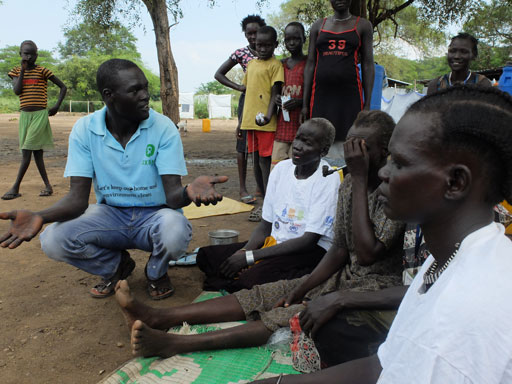12.3 Tools and methods for advocacy
How do you get support in the form of political will, funds and other resources from your leaders to facilitate WASH initiatives in your locality? There are a number of different methods that might be appropriate in different circumstances (Coulby, n.d.).
There will almost certainly be meetings involved in any advocacy campaign both with community members and with the people you are trying to influence. Organising meetings with decision makers so that you can brief them about a situation may be an effective way of raising awareness and presenting your case. Gathering all stakeholders together to discuss and coordinate activities will also be necessary.
Lobbying is a form of advocacy where a direct approach is made to legislators or other public officials about an issue. The term originates from the practice of waiting in the lobbies and corridors of government buildings in order to speak to politicians and lawmakers (Coulby, 2008). Nowadays, lobbying has a broader meaning and includes any direct attempt to influence policy, usually at national level.
Advocacy campaigns can make use of many of the communication tools we have discussed in previous study sessions including leaflets and posters that highlight the issue of concern. Messages through newspapers, radio and television programmes (also known as media advocacy) can be valuable if these facilities are available. Using entertainment such as drama and music is also a useful tool.
Being good at public speaking is an important skill for people involved in advocacy campaigns, especially those in leadership roles. It is important to be able to speak confidently and clearly if you are addressing large gatherings of people. Effective communication is also essential in smaller meetings with decision makers. They are likely to be busy people so you will need to get your message across to them quickly and clearly.
Now read Case Study 12.1 and answer the questions that follow.
Case Study 12.1, Part 1 Abebe and the dirty latrine
Abebe is an urban WASH worker in a small town in Amhara Region. Although there is a latrine in the market in his town, it is smelly and unpleasant and very few people use it. Moreover, although there is a bucket of water there, the bucket is dirty and the water is old and stagnant, so nobody uses it for handwashing. Many people avoid using these facilities altogether and a wooded area behind the market is often used for open defecation instead. Abebe has identified this as a major issue and realises that in the short term what is required is to clean up the existing facilities. In the medium term, it needs someone to clean the facilities, fill the bucket with fresh water and provide soap on a regular basis.
Identify two advocacy activities that Abebe could undertake to improve WASH service delivery.
There are many possible answers. You may have thought of two of the following:
- Raise awareness of the issue by arranging to meet local leaders.
- Arrange a meeting with the community to explore possible solutions.
- Engage opinion leaders.
- Initiate media campaigns.
- Speak at public meetings.
What would Abebe’s role be as an urban WASH practitioner in these advocacy activities?
Abebe could lead the advocacy effort or work with others as part of a team. His role would be to raise awareness of the issue to local leaders and to be a facilitator at the community meeting (Figure 12.2). He could try to identify individuals willing to clean the facility and refresh supplies of water and soap on a regular basis. He could also find out if money was available to pay them to do so and explore how much people might be prepared to pay to use the clean facility.

12.2 Goals and objectives of WASH advocacy
